Artificial vs. Natural Testing
A recent study is helping to improve the connection between laboratory and outdoor testing, thereby enhancing material service life predictions.
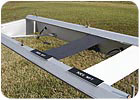
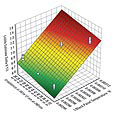 Predicting material service life is an important aspect of any quality analysis operation. However, for materials that are intended for use outdoors, developing such a prediction can be challenging. Outdoor reference laboratory exposure testing can take years to complete, significantly delaying the introduction of new products to the market. In many cases, a more desirable alternative is accelerated laboratory testing using artificial weathering devices. But can such devices accurately predict the service life of a material exposed to outdoor weather?
Predicting material service life is an important aspect of any quality analysis operation. However, for materials that are intended for use outdoors, developing such a prediction can be challenging. Outdoor reference laboratory exposure testing can take years to complete, significantly delaying the introduction of new products to the market. In many cases, a more desirable alternative is accelerated laboratory testing using artificial weathering devices. But can such devices accurately predict the service life of a material exposed to outdoor weather?
Researchers at Atlas Material Testing Technology LLC recently performed a study to help identify gaps in their understanding of applying Arrhenius models developed in artificial weathering devices to outdoor reference environment exposures and ultimately to predict material service life at locations throughout the world. The study used the yellowing of unprotected polycarbonate as the measured variable for assessing service life according to ASTM E 313-96 for 2°/C.1 A yellowness index (Y.I.) change of 6 units was arbitrarily identified as the end of useful service life for this study.
The study involved two main parts: developing an Arrhenius weathering model in artificial xenon arc exposures, and verifying the model in outdoor reference exposures. The three input variables considered by the Arrhenius model included ultraviolet (UV) light intensity, standard black panel temperature (BPT), and percent relative humidity (R.H.%). A large supply of commercially available unprotected polycarbonate was obtained, cut into 2 x 6-in. specimens and randomized. Samples of specimens were then exposed in xenon arc weather testing instrument exposures and outdoor reference laboratory exposures in Miami, FL and Phoenix, AZ. The outdoor exposures were started years before the xenon arc weather testing instrument exposures.
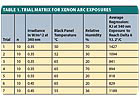
The xenon exposure used seven trials with 10 polycarbonate specimens for each trial and input variables as specified in Table 1. At convenient intervals, technicians paused the exposure and removed the specimens to measure Y.I., followed by continued exposure. Trials used shorter exposures and less frequent measurements as the study progressed since the material's degradation function appeared linear with the UV radiant exposure throughout all trials. For each specimen in each exposure, an equation for best-fit line was determined relating the change in Y.I. to the UV exposure in KJ/m^2·nm at 340 nm. These equations were then used to predict the amount of UV exposure to produce a delta Y.I. of 6 for each specimen under each exposure condition. The average prediction for each xenon arc exposure trial condition is shown in Table 1.
Once the xenon arc exposure data for each input variable combination was obtained, the next step converted input variables into an appropriate form for the Arrhenius relationship: Ln (life estimate in KJ/m^2·nm at 340 nm), UV radiant intensity in W/m^2·nm at 340 nm, 1/°K BPT, and R.H.%. The exposure input variables and dependent variable (Ln [life estimate]) were entered into a standard statistical analysis software package (Statistica 6 by StatSoft, Inc.). Simple multiple linear regression analysis was performed on the 73 data points.2 The results of this analysis are shown in Table 2. From this analysis, technicians obtained a predictive model describing the polycarbonate yellowing weathering behavior in xenon arc exposure as a function of UV irradiation level, BPT and R.H.%. Figure 1 shows the model function for two of the three variables, as well as observed data. The observed data showed reasonable agreement with predicted data from the regression model.

Five independent exposures of the polycarbonate material were performed in Miami and Phoenix at Atlas Weathering Services exposure facilities. All exposures were conducted at an angle of 5° facing south in an unbacked configuration. The five exposures started on different years and at different seasons of the year at the different locations. The change in Y.I. as a function of total UV exposure for the different tests is shown in Figure 2 (p. 42). Technicians observed the service life of the polycarbonate as approximately 380 and 450 MJ/m^2 total ultraviolet radiation (TUVR) in Miami and Phoenix, respectively, for these exposures.
Materials were exposed within 0.5 km of radiometric, BPT and R.H.% measurement devices. TUVR, BPT and R.H.% data was obtained for the years 2000 and 2003 at 30 minute intervals throughout each day of the year at these locations. Technicians constructed an average year from these data points. An example of this 30-minute average data for a single summer day in Miami is shown in Figure 3.
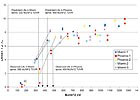
The task of inputting the 30 minute outdoor UV light intensity, BPT and R.H.% data into the Arrhenius model proved highly problematic. In the xenon arc exposures, the light intensity variable is measured in W/m^2·nm at 340 nm. In the outdoor exposure, the light intensity is measured in W/m^2·nm from 295 to 385 nm. Optimally, both the model-measured variables and the outdoor-measured variables should be measured in the same way, with devices of identical response. However, this replication of variable measurement did not exist for this study.
To obtain comparable data, technicians used a proportional approximation of UV light intensity. Sources reported that a reasonable average maximum noontime light intensity value in Miami was about 0.65 W/m^2·nm at 340 nm. Observing that the TUVR data (295-385 nm) light intensity level was about 0.065 for noontime summer in Miami, the technicians simply multiplied the observed TUVR data by 10 to obtain a proportional approximation for 340 nm W/m^2·nm light intensity. Although a very rough, crude approximation, the predicted reference environment exposure data for polycarbonate was within reasonable agreement with the observed exposure data.*
Black panel temperature measurement devices used in the outdoor reference environment differ significantly from the black panels used in the xenon arc instrument chamber. Different black coatings, metallic substrates and temperature measurement sensors may result in different temperature measurements. The technicians also did not have data correlating xenon arc BPTs to outdoor BPTs, and therefore could not apply a suitable conversion factor. Instead, they used the outdoor BPT data as an input into the Arrhenius model developed with the testing instrument BPT input. Although this represents an obvious offset in the BPT model variable and sources of error in the estimated life calculation, the predicted reference environment exposure data appeared in reasonable agreement with the observed exposure data.
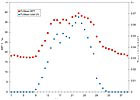
Author's note: The information presented in this article is not meant to address the service life prediction of polycarbonate but only to investigate considerations for applying service life prediction methodologies to exposure data. Further, this study is only presented to highlight some considerations for performing these types of service life prediction methodologies, and use of this information for any other purpose is not recommended.
*Atlas Material Testing Technology does not recommend use of this approximation for anything outside this project. Service life prediction efforts should use actual measured values used in determining the predictive models.
SIDEBAR:
Future service life prediction (SLP) investigations may benefit from several specific considerations noted during this study:


Figure 1. Two variable model functions from the xenon arc trials.
Researchers at Atlas Material Testing Technology LLC recently performed a study to help identify gaps in their understanding of applying Arrhenius models developed in artificial weathering devices to outdoor reference environment exposures and ultimately to predict material service life at locations throughout the world. The study used the yellowing of unprotected polycarbonate as the measured variable for assessing service life according to ASTM E 313-96 for 2°/C.1 A yellowness index (Y.I.) change of 6 units was arbitrarily identified as the end of useful service life for this study.
The study involved two main parts: developing an Arrhenius weathering model in artificial xenon arc exposures, and verifying the model in outdoor reference exposures. The three input variables considered by the Arrhenius model included ultraviolet (UV) light intensity, standard black panel temperature (BPT), and percent relative humidity (R.H.%). A large supply of commercially available unprotected polycarbonate was obtained, cut into 2 x 6-in. specimens and randomized. Samples of specimens were then exposed in xenon arc weather testing instrument exposures and outdoor reference laboratory exposures in Miami, FL and Phoenix, AZ. The outdoor exposures were started years before the xenon arc weather testing instrument exposures.

Artificial Laboratory Weathering
The purpose of the artificial laboratory weathering trials was to understand considerations for developing Arrhenius type service life prediction models using xenon arc exposure devices. Artificial laboratory exposures were conducted in Atlas model Ci5000 and Ci4000 Weather-Ometers® with no spray and no dark cycles. The exposures used a quartz inner/borosilicate outer filter combination. Irradiance levels, BPT and R.H.% levels were adjusted to a variety of levels for seven trials in this study.The xenon exposure used seven trials with 10 polycarbonate specimens for each trial and input variables as specified in Table 1. At convenient intervals, technicians paused the exposure and removed the specimens to measure Y.I., followed by continued exposure. Trials used shorter exposures and less frequent measurements as the study progressed since the material's degradation function appeared linear with the UV radiant exposure throughout all trials. For each specimen in each exposure, an equation for best-fit line was determined relating the change in Y.I. to the UV exposure in KJ/m^2·nm at 340 nm. These equations were then used to predict the amount of UV exposure to produce a delta Y.I. of 6 for each specimen under each exposure condition. The average prediction for each xenon arc exposure trial condition is shown in Table 1.
Once the xenon arc exposure data for each input variable combination was obtained, the next step converted input variables into an appropriate form for the Arrhenius relationship: Ln (life estimate in KJ/m^2·nm at 340 nm), UV radiant intensity in W/m^2·nm at 340 nm, 1/°K BPT, and R.H.%. The exposure input variables and dependent variable (Ln [life estimate]) were entered into a standard statistical analysis software package (Statistica 6 by StatSoft, Inc.). Simple multiple linear regression analysis was performed on the 73 data points.2 The results of this analysis are shown in Table 2. From this analysis, technicians obtained a predictive model describing the polycarbonate yellowing weathering behavior in xenon arc exposure as a function of UV irradiation level, BPT and R.H.%. Figure 1 shows the model function for two of the three variables, as well as observed data. The observed data showed reasonable agreement with predicted data from the regression model.

Outdoor Reference Weathering
The purpose of the outdoor reference environment weathering was to expose the same polycarbonate material to real, variable outdoor weather while carefully measuring the variables that were controlled in the xenon arc exposure trials. The intent was to see whether the Arrhenius model could use measured levels of UV light intensity, BPT and R.H.% obtained outdoors for a prediction of service life that was in reasonable agreement with observed service life. By performing outdoor exposure of the polycarbonate material at the reference exposure laboratories, technicians obtained frequent measurements of UV light intensity, BPT and R.H.% at the same location as the material's outdoor exposure.Five independent exposures of the polycarbonate material were performed in Miami and Phoenix at Atlas Weathering Services exposure facilities. All exposures were conducted at an angle of 5° facing south in an unbacked configuration. The five exposures started on different years and at different seasons of the year at the different locations. The change in Y.I. as a function of total UV exposure for the different tests is shown in Figure 2 (p. 42). Technicians observed the service life of the polycarbonate as approximately 380 and 450 MJ/m^2 total ultraviolet radiation (TUVR) in Miami and Phoenix, respectively, for these exposures.
Materials were exposed within 0.5 km of radiometric, BPT and R.H.% measurement devices. TUVR, BPT and R.H.% data was obtained for the years 2000 and 2003 at 30 minute intervals throughout each day of the year at these locations. Technicians constructed an average year from these data points. An example of this 30-minute average data for a single summer day in Miami is shown in Figure 3.

Figure 2. Example of single day black panel temperatures and irradiance values in Florida exposure.
Linking Laboratory and Outdoor Data
Using the Arrhenius model developed in the xenon arc exposure trials to predict outdoor weathering conceptually involves a simple process of measuring the input variables observed in the outdoor environment, putting these values into the model and calculating the function for these outdoor variable levels. In this study, technicians performed exposures and variable measurements at the same exposure locations to allow for a close comparison between predicted results from the model with observed results from the outdoor exposures. Currently, this process appears to be one of the largest sources of error in applying the developed models because very considerable differences exist between the variable measurements of the xenon arc weather testing instrument compared with the variable measurements of the outdoor reference exposures.The task of inputting the 30 minute outdoor UV light intensity, BPT and R.H.% data into the Arrhenius model proved highly problematic. In the xenon arc exposures, the light intensity variable is measured in W/m^2·nm at 340 nm. In the outdoor exposure, the light intensity is measured in W/m^2·nm from 295 to 385 nm. Optimally, both the model-measured variables and the outdoor-measured variables should be measured in the same way, with devices of identical response. However, this replication of variable measurement did not exist for this study.
To obtain comparable data, technicians used a proportional approximation of UV light intensity. Sources reported that a reasonable average maximum noontime light intensity value in Miami was about 0.65 W/m^2·nm at 340 nm. Observing that the TUVR data (295-385 nm) light intensity level was about 0.065 for noontime summer in Miami, the technicians simply multiplied the observed TUVR data by 10 to obtain a proportional approximation for 340 nm W/m^2·nm light intensity. Although a very rough, crude approximation, the predicted reference environment exposure data for polycarbonate was within reasonable agreement with the observed exposure data.*
Black panel temperature measurement devices used in the outdoor reference environment differ significantly from the black panels used in the xenon arc instrument chamber. Different black coatings, metallic substrates and temperature measurement sensors may result in different temperature measurements. The technicians also did not have data correlating xenon arc BPTs to outdoor BPTs, and therefore could not apply a suitable conversion factor. Instead, they used the outdoor BPT data as an input into the Arrhenius model developed with the testing instrument BPT input. Although this represents an obvious offset in the BPT model variable and sources of error in the estimated life calculation, the predicted reference environment exposure data appeared in reasonable agreement with the observed exposure data.

Figure 3. Observed reference exposure results compared to predicted model results.
Observed vs. Predicted Results
To use the Arrhenius model developed with the xenon arc exposures, technicians took the 30 minute outdoor variable data (calculated as explained previously), entered the UV light intensity approximation, BPT and R.H.% value for each 30 minute interval into the Arrhenius calculation, and obtained a value for expected degradation for that 30 minute period. All data points for which the light intensity was zero (nighttime) were disregarded, and all the individual values for the duration of the exposures were summed. The model predicted estimates for service life are compared to the actual observed values in Figure 3. In both exposure environments, the predicted service life estimate differed from the observed service life by less than 15%. Given the differences in variable measurement and the crude approximations undertaken in the calculation, this level of agreement was unexpected for a first approximation.Ensuring Accurate Predictions
Accelerated laboratory testing using artificial weathering devices is not an exact substitute for natural outdoor testing. However, advances are continuously being made in the accuracy of such instruments through studies such as the one described in this article. As a result, today's artificial weathering devices can be used to reliably predict service life with a small margin of error. Further reliability is gained by combining accelerated laboratory testing with natural outdoor testing to allow for a more detailed survey of the various processes occurring at the molecular level.Author's note: The information presented in this article is not meant to address the service life prediction of polycarbonate but only to investigate considerations for applying service life prediction methodologies to exposure data. Further, this study is only presented to highlight some considerations for performing these types of service life prediction methodologies, and use of this information for any other purpose is not recommended.
*Atlas Material Testing Technology does not recommend use of this approximation for anything outside this project. Service life prediction efforts should use actual measured values used in determining the predictive models.
SIDEBAR:
Artificial Reference Exposure Comparison Considerations
Future service life prediction (SLP) investigations may benefit from several specific considerations noted during this study:- SLP efforts should provide for identical exposure variable measurements in the xenon arc exposures, at the outdoor reference exposure locations and at the worldwide exposure locations.
- The UV light intensity measurements in the xenon arc chambers should be duplicated in the outdoor exposures.
- The BPT measurements in the xenon arc chambers should be duplicated in the outdoor exposures.
- Further studies should consider actual material surface temperature measurements rather than BPT data for use in predictive models.
- The methods and frequencies for measuring environmental variables should be standardized throughout outdoor reference exposure laboratories and worldwide exposure locations.
- Future SLP investigations should consider using virtual environmental variable data (as generated from weather modeling software), as well as actual measured environmental variable data to compare differences with observed exposure service life and life estimates from modeled weather variables.
- Models developed from xenon arc exposures using Arrhenius approaches yielded first approximations with reasonable agreement to outdoor observed values, while regression models without Arrhenius concepts appeared very limited for outdoor predictions in this study.
- It may be possible to perform correlation studies to obtain conversion factors for W/m^2_nm at 340 nm to TUVR MJ/m^2 in order to enhance first approximations.
- Both the two-variable (UV intensity and BPT) and three-variable models (UV intensity, BPT and R.H.%) explained most of the variation observed in the xenon arc trials of this study.
- The xenon arc air chamber temperature variable did not contribute significantly to the predictive model developed in this study.
- The frequent environmental data logging from the reference exposure locations (30 minute intervals) appeared sufficiently frequent for the first approximations of this study.
- It appears highly desirable to obtain worldwide exposure durations expressed as UV exposure rather than as months time duration.
- The averaging and approximation techniques used for putting environmental variable data into predictive models, although undesirable, appeared effective for the first approximations of this study
- It appeared important to disregard nighttime data in the predictive calculations.
Looking for a reprint of this article?
From high-res PDFs to custom plaques, order your copy today!




